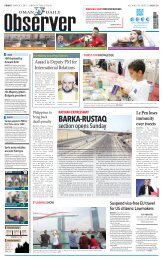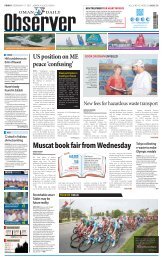GROWING
ICLt100AJRg
ICLt100AJRg
Create successful ePaper yourself
Turn your PDF publications into a flip-book with our unique Google optimized e-Paper software.
SATURDAY | FEBRUARY 18, 2017 | JUMADA AL ULA 21, 1438 AH<br />
business<br />
follow us @oman_biz<br />
www.omanobserver.om<br />
editor@omanobserver.om<br />
ASIAN SHARES RISE AS US RATES EASE P16 ALLIANZ WARNS YEAR AHEAD UNCERTAIN AFTER STRONG 2016 P16 ESSENTRA FY PROFIT FALLS 26PC ON INTEGRATION WOES16<br />
Oman awards first-ever contract<br />
extension to private power plant<br />
FRESH LEASE OF LIFE: Al Kamil Power receives 4-year contract extension<br />
CONRAD PRABHU<br />
MUSCAT, FEB. 17<br />
Oman Power and Water Procurement Company<br />
(OPWP), the nation’s principal procurement of new<br />
electricity generation and water desalination capacity,<br />
has inked a deal that formally allows Al Kamil Power<br />
— one of Oman’s earliest Independent Power Projects<br />
(IPP) — to remain in operation for a further four years<br />
beyond its existing contract which expires this year.<br />
Under the terms of an extended Power Purchase<br />
Agreement (PPA) signed late last week, Al Kamil Power<br />
Company SAOG, which operates a 280 megawatt (MW)<br />
gas-powered plant in South Al Sharqiyah Governorate,<br />
will continue to be in service up to December 31, 2021.<br />
It follows the successful completion of negotiations<br />
with OPWP, a subsidiary of the wholly governmentowned<br />
Nama Group, leading to a contract extension<br />
with revised terms and conditions, the company said<br />
in a filing to the Capital Market Authority (CMA) on<br />
Thursday.<br />
Significantly, the extended PPA is the first of a<br />
number of similar pacts planned by OPWP that will<br />
allow for some of Oman’s oldest privately owned power<br />
plants to stay in operation well beyond the expiry of<br />
their current contracts. This, alongside options to<br />
procure new capacity, is key to the procurer’s strategy to<br />
ensure adequate capacity to meet galloping electricity<br />
demand growth<br />
“Extensions are being negotiated only on a<br />
guaranteed capacity basis at economic commercial<br />
terms, and all plants have completed independent<br />
technical evaluations to confirm the capacity on offer,”<br />
The extended PPA is the first<br />
of a number of similar pacts<br />
planned by OPWP that will<br />
allow for some of Oman’s<br />
oldest privately owned power<br />
plants to stay in operation<br />
well beyond the expiry of<br />
their current contracts<br />
the procurer said in its 7-Year Outlook Statement for<br />
the 2016-2022 timeframe.<br />
Also expected to receive a contract extension<br />
is Barka-1 Independent Power Project, which is<br />
co-located with a water desalination plant. With<br />
the existing Power & Water Purchase Agreement<br />
(PWPA) due to expire next year, OPWP has already<br />
initiated negotiations with the plant owner, ACWA<br />
Power Barka, for a contract extension up to December<br />
31, 2021.<br />
An extended contract will see Barka-1 offering 388<br />
MW of capacity during normal operation in Combined<br />
Cycle Generation Turbine (CCGT) mode without<br />
water production from the multi-stage flash (MSF)<br />
component of its desalination capacity. However, if<br />
water capacity has to be operationalised in the event of<br />
a contingency, then Barka-1 will offer up to 435MW of<br />
generation capacity, according to OPWP.<br />
However, for Manah Power — the Sultanate’s first<br />
Independent Power Project — ownership of the plant<br />
transfers to the government upon the expiry of the<br />
current Power Purchase Agreement in December 2020.<br />
OPWP says it is weighing a number of options for<br />
the continued operation of the 264 MW capacity plant,<br />
including a competitive tender for the sale of the asset,<br />
backed by a multi-year Power Purchase Agreement.<br />
While the Al Kamil Power contract extension is<br />
the first for privately owned plants, older state-owned<br />
generation assets in Al Ghubra (Muscat Governorate)<br />
and Wadi Jizzi (Buraimi Governorate) have already<br />
received new leases of life — for part of their capacity<br />
at least.<br />
Contracts for several gas turbine units of Al Ghubra,<br />
offering up to 405 MW of capacity, have been extended<br />
up to September 30, 2018, when the plant will be fully<br />
retired. Similar extensions have also been granted to<br />
a number of gas turbine units at Wadi Jizzi, enabling<br />
326 MW of capacity to be available until September 30,<br />
2018, when the plant is also planned for retirement.<br />
Importantly, future contract extensions for Al<br />
Kamil, Barka-1 and other plants nearing the end<br />
of their contract, are possible under a new capacity<br />
procurement strategy that OPWP plans to unveil later<br />
this year. The strategy, which is aimed at liberalizing<br />
the electricity sector and opening it up for competition<br />
for the first time, will enable existing power plants with<br />
expiring contracts to compete directly with new project<br />
bidders for long-term contracts.<br />
“The first capacity procurement to use this new<br />
methodology is expected to be for contract terms<br />
beginning in 2022,” said OPWP.<br />
Samsung chief Lee<br />
arrested as S Korean<br />
graft probe deepens<br />
SEOUL: Samsung Group Chief Jay Y Lee was arrested on Friday<br />
over his alleged role in a corruption scandal rocking the highest<br />
levels of power in South Korea, dealing a fresh blow to the<br />
technology giant and standard-bearer for Asia’s fourth-largest<br />
economy.<br />
The special prosecutor’s office accuses Lee of bribing a<br />
close friend of President Park Geun-Hye to gain government<br />
favours related to leadership succession at the conglomerate. It<br />
said on Friday it will indict him on charges including bribery,<br />
embezzlement, hiding assets overseas and perjury.<br />
The 48-year-old Lee, scion of the country’s richest family, was<br />
taken into custody at the Seoul Detention Centre early on Friday<br />
after waiting there overnight for the decision. He was being held<br />
in a single cell with a TV and desk, a jail official said.<br />
Lee is a suspect in an influence-peddling scandal that led<br />
parliament to impeach Park in December, a decision that if<br />
upheld by the Constitutional Court would make her the country’s<br />
first democratically elected leader forced from office.<br />
Samsung and Lee have denied wrongdoing in the case.<br />
Prosecutors have up to 10 days to indict Lee, Samsung’s thirdgeneration<br />
leader, although they can seek an extension. After<br />
indictment, a court would be required to make its first ruling<br />
within three months. Prosecutors plan to question Lee again on<br />
Saturday.<br />
No decision had been made on whether Lee’s arrest would be<br />
contested or whether bail would be sought, a spokeswoman for<br />
Samsung Group said.<br />
Samsung Group Chief, Jay Y Lee, is surrounded by media upon<br />
his arrival to the Seoul Central District Court in Seoul. — Reuters<br />
“We will do our best to ensure that the truth is revealed in<br />
future court proceedings,” the Samsung Group said in a brief<br />
statement after Lee’s arrest. The same court had rejected a request<br />
last month to arrest Lee, but prosecutors this week brought<br />
additional accusations against him. “We acknowledge the cause<br />
and necessity of the arrest,” a judge said in his ruling.<br />
The judge rejected the prosecution’s request to also arrest<br />
Samsung Electronics president Park Sang-Jin.<br />
Shares in Samsung Electronics ended on Friday down 0.42 per<br />
cent in a flat wider market. Ratings agencies did not expect any<br />
impact on the flagship firm’s credit ratings, and said Lee’s arrest<br />
would accelerate improvements in management transparency<br />
and corporate governance. — Reuters<br />
US housing starts drop; permits rise to one-year high<br />
WASHINGTON: US homebuilding<br />
fell in January as the construction<br />
of multi-family housing projects<br />
dropped, but upward revisions to<br />
the prior month’s data and a jump in<br />
permits to a one-year high suggested<br />
the housing recovery remained on<br />
track.<br />
Other data on Thursday showed<br />
only a modest increase in the number<br />
of Americans filing new applications<br />
for unemployment benefits last week,<br />
a sign that the labour market was<br />
continuing to tighten.<br />
Housing starts fell 2.6 per cent<br />
to a seasonally adjusted annual rate<br />
of 1.25 million units last month,<br />
the Commerce Department said.<br />
December’s starts were revised up to<br />
a rate of 1.28 million units from the<br />
previously reported 1.23 million pace.<br />
Homebuilding was up 10.5 per cent<br />
compared to January 2016. Permits<br />
for future construction jumped 4.6<br />
per cent in January to a rate of 1.29<br />
million units, the highest level since<br />
November 2015. Building permits in<br />
the South, where most homebuilding<br />
occurs, hit their highest level since July<br />
2007.<br />
With overall permits now<br />
outpacing starts, homebuilding is<br />
likely to rebound in the coming<br />
months. Economists polled by Reuters<br />
had forecast ground breaking activity<br />
slipping to a rate of 1.22 million units<br />
last month and building permits rising<br />
to a 1.23 million pace.<br />
Prices of US Treasuries slid and<br />
US stock index futures trimmed losses<br />
after the data. The dollar pared losses<br />
against a basket of currencies.<br />
The housing recovery is being<br />
driven by a strong labour market,<br />
which is boosting employment<br />
opportunities for young people and<br />
supporting household formation.<br />
In a separate report, the Labour<br />
Department said initial claims for state<br />
unemployment benefits rose 5,000 to<br />
A house under construction has a sold sign out front in the Candelas development<br />
in the northwest Denver suburb of Arvada, Colorado. — Reuters<br />
a seasonally adjusted 239,000 for the<br />
week ended February 11.<br />
Claims have been below 300,000,<br />
a threshold associated with a strong<br />
job market, for 102 consecutive weeks.<br />
That is the longest stretch since 1970,<br />
when the labour market was much<br />
smaller. The labour market is at or<br />
close to full employment, with the<br />
unemployment rate at 4.8 per cent.<br />
Economists had forecast firsttime<br />
applications for jobless benefits<br />
rising to 245,000 in the latest week.<br />
While the labour market is expected<br />
* Housing starts fall<br />
2.6 per cent in Jan<br />
* Building permits<br />
increase 4.6 per cent<br />
* Weekly jobless<br />
claims rise by 5,000<br />
to continue to underpin the housing<br />
market, higher mortgage rates could<br />
slow demand for housing. A survey<br />
on Wednesday showed homebuilders’<br />
confidence slipped in February but<br />
remained at levels consistent with a<br />
growing housing market. Builders<br />
anticipated a slowdown in buyer<br />
traffic and continued to grapple with<br />
shortages of developed lots and skilled<br />
labour.<br />
January’s starts were above the<br />
fourth-quarter average, suggesting<br />
housing will again contribute to gross<br />
domestic product in the first three<br />
months of this year.<br />
Homebuilding last month surged<br />
55.4 per cent in the Northeast region<br />
of the country. It jumped 20.0 per cent<br />
in the South to the highest level since<br />
August 2007. Starts fell 41.3 per cent<br />
in the West, likely due to the impact of<br />
unusually wet weather.<br />
Last month, single-family<br />
homebuilding, which accounts for the<br />
largest share of the residential housing<br />
market, climbed 1.9 per cent to a pace<br />
of 823,000 units.<br />
Starts for the volatile multi-family<br />
housing segment tumbled 10.2 per<br />
cent to a rate of 423,000 units.<br />
Single-family permits slipped 2.7<br />
per cent last month after increasing for<br />
five consecutive months. Single-family<br />
starts in the South rose to their highest<br />
level since August 2007.<br />
Building permits for multi-family<br />
units soared 19.8 per cent. — Reuters









